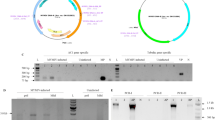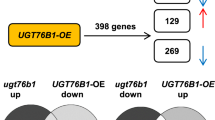Abstract
Recognition of bacterial effector proteins by plant cells is crucial for plant disease and defense response signaling. The Xanthomonas campestris pv. vesicatoria (Xcv) type III effector protein, AvrBsT, is secreted into plant cells from Xcv strain Bv5-4a. Here, we demonstrate that dexamethasone (DEX): avrBsT overexpression triggers cell death signaling in healthy transgenic Arabidopsis plants. AvrBsT overexpression in Arabidopsis also reduced susceptibility to infection with the obligate biotrophic oomycete Hyaloperonospora arabidopsidis. Overexpression of avrBsT significantly induced some defense-related genes in Arabidopsis leaves. A high-throughput in planta proteomics screen identified TCP-1 chaperonin, SEC7-like guanine nucleotide exchange protein and calmodulin-like protein, which were differentially expressed in DEX:avrBsT-overexpression (OX) Arabidopsis plants during Hp. arabidopsidis infection. Treatment with purified GST-tagged AvrBsT proteins distinctly inhibited the growth and sporulation of Hp. arabidopsidis on Arabdiopsis cotyledons. In contrast, DEX:avrBsT-OX plants exhibited enhanced susceptibility to Pseudomonas syringae pv. tomato (Pst) DC3000 infection. Notably, susceptible cell death and enhanced electrolyte leakage were significantly induced in the Pst-infected leaves of DEX:avrBsT-OX plants. Together, these results suggest that Xcv effector AvrBsT overexpression triggers plant cell death, disease and defense signaling leading to both disease and defense responses to microbial pathogens of different lifestyles.








Similar content being viewed by others
Abbreviations
- DAB:
-
3′-diaminobenzidine
- DEX:
-
Dexamethasone
- H2O2 :
-
Hydrogen peroxide
- HR:
-
Hypersensitive response
- OX:
-
Overexpression
- PR:
-
Pathogenesis-related
- Pst :
-
Pseudomonas syringae pv. tomato
- ROS:
-
Reactive oxygen species
- Xcv :
-
Xanthomonas campestris pv. vesicatoria
References
Axtell MJ, Staskawicz BJ (2003) Initiation of RPS2-specified disease resistance in Arabidopsis is coupled to the AvrRpt2-directed elimination of RIN4. Cell 112:369–377
Bartetzko V, Sonnewald S, Vogel F, Hartner K, Stadler R, Hammes UZ, Börnke F (2009) The Xanthomonas campestris pv. vesicatoria type III effector protein XopJ inhibits protein secretion: evidence for interference with cell wall-associated defense responses. Mol Plant–Microbe Interact 22:655–664
Bindschedler LV, Manibayeva F, Gardber SL, Gerrish C, Davies DR, Bolwell GP (2001) Early signaling events in the apoplastic oxidative burst in suspension cultured French bean cells involved cAMP and Ca2+. New Phytol 151:185–194
Block A, Li G, Fu ZQ, Alfano JR (2008) Phytopathogen type III effector weaponry and their plant targets. Curr Opin Plant Biol 11:396–403
Brodersen P, Petersen M, Pike HM, Olszak B, Skov S, Ødum N, Jørgensen LB, Brown RE, Mundy J (2002) Knockout of Arabidopsis ACCELERATED-CELL-DEATH11 encoding a sphingosine transfer protein cause activation of programmed cell death and defense. Genes Dev 16:490–502
Büttner D, Bonas U (2010) Regulation and secretion of Xanthomonas virulence factors. FEMS 34:107–133
Büttner D, He SY (2009) Type III protein secretion in plant pathogenic bacteria. Plant Physiol 150:1656–1664
Cheong YH, Sung SJ, Cho JS, Luan S (2010) Constitutive overexpression of the calcium sensor CBL5 confers osmotic or drought stress tolerance in Arabidopsis. Mol Cells 29:159–165
Choi DS, Hwang BK (2011) Proteomics and functional analyses of pepper abscisic acid-responsive 1 (ABR1), which is involved in cell death and defense signaling. Plant Cell 23:823–842
Choi HW, Kim YJ, Hwang BK (2011) The hypersensitive induced reaction and leucine-rich repeat proteins regulate plant cell death associated with disease and plant immunity. Mol Plant–Microbe Interact 24:68–78
Choi DS, Hwang IS, Hwang BK (2012) Requirement of the cytosolic interaction between PATHOGENESIS-RELATED PROTEIN10 and LEUCINE-RICH REPEAT PROTEIN1 for cell death and defense signaling in pepper. Plant Cell 24:1675–1690
Clough SJ, Bent AF (1998) Floral dip: a simplified method for Agrobacterium-mediated transformation of Arabidopsis thaliana. Plant J 16:735–743
Cui H, Wang Y, Xue L, Chu J, Yan C, Fu J, Chen M, Innes RW, Zhou JM (2010) Pseudomonas syringae effector protein AvrB perturbs Arabidopsis hormone signaling by activating MAP kinase 4. Cell Host Microbe 7:164–175
Cunnac S, Wilson A, Nuwer J, Kirik A, Baranage G, Mudgett MB (2007) A conserved carboxylesterase is a SUPPRESSOR OF AVRBST-ELICITED RESISTANCE in Arabidopsis. Plant Cell 19:688–705
DebRoy S, Thilmony R, Kwack YB, Nomura K, He SY (2004) A family of conserved bacterial effectors inhibits salicylic acid-mediated basal immunity and promotes disease necrosis in plants. Proc Natl Acad Sci USA 101:9927–9932
Eitas TK, Nimchuk ZL, Dangl JL (2008) Arabidopsis TAO1 is a TIR-NB-LRR protein that contributes to disease resistance induced by the Pseudomonas syringae effector AvrB. Proc Natl Acad Sci USA 105:6475–6480
Flors V, Ton J, Jakab G, Mauch-Mani B (2005) Abscisic acid and callose: team players in defence against pathogens? J Phytopathol 153:377–383
Göhre V, Robatzek S (2008) Breaking the barriers: microbial effector molecules subvert plant immunity. Annu Rev Phytopathol 46:180–215
Greenberg JT (1997) Programmed cell death in plant–pathogen interactions. Annu Rev Plant Physiol Plant Mol Biol 48:525–545
Greenberg JT, Yao N (2004) The role and regulation of programmed cell death in plant-pathogen interactions. Cell Microbiol 6:201–211
Hwang IS, Hwang BK (2010) The pepper 9-lipoxygenase gene CaLOX1 functions in defense and cell death responses to microbial pathogens. Plant Physiol 152:948–967
Hwang IS, An SH, Hwang BK (2011) Pepper asparagine synthetase 1 (CaAS1) is required for plant nitrogen assimilation and defense responses to microbial pathogens. Plant J 67:749–762
Jones JDG, Dangl JL (2006) The plant immune system. Nature 444:323–329
Jones JB, Stall RE, Bouzar H (1998) Diversity among Xanthomonads pathogenic on pepper and tomato. Annu Rev Phytopathol 36:41–58
Jones JB, Lacy GH, Bouzar H, Stall RE, Schaad NW (2004) Reclassification of the Xanthomonads associated with bacterial spot disease of tomato and pepper. Syst Appl Micobiol 27:755–762
Kim J-G, Li X, Roden JA, Taylor KW, Aakre CD, Su B, Lalonde S, Kiril A, Chen Y, Baranage G, McLane H, Martin GB, Mudgett MB (2009) Xanthomonas T3S effector XopN suppresses PAMP-triggered immunity and interacts with a tomato atypical receptor-like kinase and TFT1. Plant Cell 21:1305–1323
Kim NK, Choi HW, Hwang BK (2010) Xanthomonas campestris pv. vesicatoria effector AvrBsT induces cell death in pepper, but suppresses defense responses in tomato. Mol Plant–Microbe Interact 23:1069–1082
Kirchhoff SR, Gupta S, Knowlton AA (2002) Cytosolic heat shock protein 60, apoptosis, and myocardial injury. Circulation 105:2899–2904
Kirik A, Mudgett MB (2009) SOBER1 phospholipase activity suppresses phosphatidic acid accumulation and plant immunity in response to bacterial effector AvrBsT. Proc Natl Acad Sci USA 106:20532–20537
Lewis JD, Lee A, Ma W, Zhou H, Guttman DS, Desveaux D (2011) The YopJ superfamily in plant-associated bacteria. Mol Plant Pathol 12:928–937
Luan S (2009) The CBL-CIPK network in plant calcium signaling. Trends Plant Sci 14:37–42
McDowell JM, Cuzick A, Can C, Beynon J, Dangl JL, Holub EB (2000) Downy mildew (Peronospora parasitica) resistance genes in Arabidopsis vary in functional requirements for NDR1, EDS1, NPR1 and salicylic acid accumulation. Plant J 22:23–529
Nimchuk Z, Marois E, Kjemtrup S, Leister RT, Katagiri F, Dangl JL (2000) Eukaryotic fatty acylation drives plasma membrane targeting and enhances function of several type III effector proteins from Pseudomonas syringae. Cell 101:353–363
Orth K, Xu Z, Mudgett MB, Bao ZQ, Palmer LE, Bliska JB, Mangel WF, Staskawicz B, Dixon JE (2000) Disruption of signaling by Yersinia effector YopJ, a ubiquitin-like protein protease. Science 290:1594–1597
Pagnussat GC, Yu H-J, Ngo QA, Rajani S, Mayalagu S, Johnson CS, Capron A, **e L-F, Ye D, Sundaresan V (2005) Genetic and molecular identification of genes required for female gametophyte development and function in Arabidopsis. Development 132:603–614
Reymond P, Farmer EE (1998) Jasmonate and salicylate as global signals for defense gene expression. Curr Opin Plant Biol 1:404–411
Roden J, Belt B, Ross J, Tachibana T, Bargas J, Mudgett MB (2004) Genetic screen to isolate type III effectors translocated into plant cells during Xanthomonas campestris pv. vesicatoria infection. Proc Natl Acad Sci USA 101:16624–16629
Ryan RP, Vorhölter FJ, Potnis N, Jones JB, Van Sluys MA, Bogdanove AJ, Dow JM (2011) Pathogenomics of Xanthomonas:understanding bacterium–plant interactions. Nat Rev Microbiol 9:344–355
Shang Y, Li X, Cui H, He P, Thilmony R, Chintamanani S, Zwiesler-Vollick J, Gopalan S, Tang X, Zhou JM (2006) RAR1, a central player in plant immunity, is targeted by Pseudomonas syringae effector AvrB. Proc Natl Acad Sci USA 103:19200–19205
Stall RE, Jones JB, Minsavage GV (2009) Durability of resistance in tomato and pepper to Xanthomonads causing bacterial spot. Annu Rev Phytopathol 47:265–284
Stulemeijer IJ, Joosten MH (2008) Post-translational modification of host proteins in pathogen-triggered defence signaling in plant. Mol Plant Pathol 9:545–560
Szczesny R, Buttner D, Escolar L, Schulze S, Seiferth A, Bonas U (2010) Suppression of the AvrBs1-specific hypersensitive response by the YopJ effector homolog AvrBsT from Xanthomonas depends on a SNF1-related kinase. New Phytol 187:1058–1074
Tsan M-F, Gao B (2009) Heat shock proteins and immune system. J Leukoc Biol 85:905–910
Wilton M, Subramaniam R, Elmore J, Felsensteiner C, Coaker G, Desveaux D (2010) The type III effector HopF2Pto targets Arabidopsis RIN4 protein to promote Pseudomonas syringae virulence. Proc Natl Acad Sci USA 107:2349–2354
Acknowledgments
This work was supported by the Next Generation BioGreen21 Program (Plant Molecular Breeding Center; Grant No. PJ008027), Rural Development Administration, Republic of Korea.
Author information
Authors and Affiliations
Corresponding author
Additional information
I. S. Hwang and N. H. Kim contributed equally to this work.
Electronic supplementary material
Below is the link to the electronic supplementary material.
425_2012_1672_MOESM1_ESM.pdf
Supplementary Fig. 1. Growth phenotypes of wild-type (Col-0) and DEX:avrBsT-OX transgenic Arabidopsis plants (lines #3, #4 and #5) at 1-, 2- and 5-week-old plant developmental stages. All the plants non-treated with dexamethasone (DEX) did not show any cell death phenotype on the leaves (PDF 60 kb)
Rights and permissions
About this article
Cite this article
Hwang, I.S., Kim, N.H., Choi, D.S. et al. Overexpression of Xanthomonas campestris pv. vesicatoria effector AvrBsT in Arabidopsis triggers plant cell death, disease and defense responses. Planta 236, 1191–1204 (2012). https://doi.org/10.1007/s00425-012-1672-4
Received:
Accepted:
Published:
Issue Date:
DOI: https://doi.org/10.1007/s00425-012-1672-4




